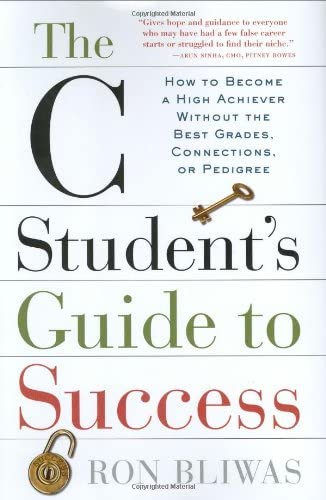Many authors have attempted to write a motivational book for C students. The C Student's Guide to Success by Ron Bliwas was an old book I found in a second-hand bookstore for $5.90, so I thought it would be a novel take on success.
I think the first problem is figuring out who a C student in Singapore is. The author's idea of a C student is someone who comes from a State University in the US with an average GPA. It's not apparent how this translates into Singapore. Law students in NUS often get a C grade but get snapped up quite quickly in the workforce, with salaries hitting over $5,000 per month and an employment rate of 100%.
If we pitch the book to non-degree holders, then the question is whether a significant part of the audience would even take the initiative to hunt down the reading in the first place. Singaporeans, students of all grades, have an aversion to reading after going through the education system. My observation of non-degree readers is that they are more attracted to Robert Kiyosaki and Gary Vaynerchuck because they are chock full of quotable quotes.
So I suppose a book on C Students from the US should translate to someone who gets an ok grade in a newer local university like SIT, SUSS or a private university like SIM.
The next question I want to ask when reading this work is what's preventing A students from enjoying the book?
I believe that A students should take the initiative to hunt down books that target C students because it tells us how C students caricature A students. In this book, I find the usual diatribe that A students have a life too easy and lack emotional intelligence. I'm not too keen to disagree with the author here because companies hire A students to do heavy-duty analysis and have a lot more responsibilities at a younger age, so based on comparative advantage alone, they may not have the incentive to develop a "service mindset".
The next question is what kind of advice we can give C students that generally would not be useful to A students. That is something that I sense that the author has failed to do adequately. The advice to be a good human being, share credit when it is due, develop salesmanship skills, and find a good mentor works for everyone. With A students reaching management ranks earlier, it may be even more crucial, leading to a stronger corporate culture.
I find two pieces of advice particularly useful specifically to C students.
One piece of advice would be to identify a working environment that would give them a chance to excel and thrive.
Many corporate environments may hire C students but will only groom A students for upper management, so savvy C students may need to hop around until they find the right domain, likely in the SME space. The author correctly identifies that "shopping around" for the right environment is dangerous for C students because they suffer more considerable risks when resigning from a steady-paying job.
The second advice is to do work that nobody likes to do.
This is the opposite of what an A student should do: to do work that gives them maximum visibility. In my observations in my current industry, I would say that the most admired role model is a paralegal rather than a lawyer because he honed his skill over 40 years to become the backbone of the firm. More importantly, his success is multigenerational, with his children already forming successful families, and he has beautiful grandkids. This is not something many A students are even able to dream of in this current economy. Many A students are BBFA and would rather watch clips of Siew Puiyi than develop a connection with someone.
Suppose someone puts a gun to my head and forces me to advise a non-degree Singaporean student today. In that case, I will ask them to shadow and eventually become a backbone for an SME that will cherish their participation. It may mean faithfully showing up for 8-10 years doing residual work from IT automation that no PMET wants to do. Eventually, you will end up owning the entire company because no one will know what will break down if you suddenly disappear one day.
Of course, that's easier said than done.
We live in an age of crypto, real estate asset tokenization, NFTs and the metaverse. Critical in the construction of crypto-tokenomics is in allowing a young single male to dispense with the delay of gratification and gives them something to flex on a Tinder date. As I have alluded to on this blog, during the heyday of crypto, if a program like Anchor can return 20% per annum, which young man in his right mind would devote the time and effort to become the backbone of an SME?
This book is now very much dated and written by someone in the advertising industry. It remains to be seen how a book like this could be written in this new era.
Maybe one of you can get ChatGPT to write the next one.

No comments:
Post a Comment